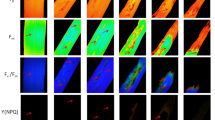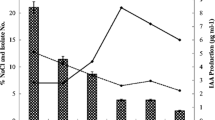Abstract
Pyrenophora teres causes one of the most destructive barley diseases in semi-arid production areas worldwide. With the burgeoning issue of soil salinization, this study focused on the effect of salt in combination with temperature and light on growth of P. teres and the response of barley to the pathogen. The growth of four isolates of P. teres (Pt12, Pt14, Pt16 and Pt18) was dependent on the media (potato dextrose agar (PDA), oatmeal agar or carrot meal agar). The growth of the P. teres isolates decreased with increasing NaCl concentration from 50 to 700 mM (except Pt14 at 50 mM) in comparison to 0 mM on PDA. At 0 to 150 mM NaCl P. teres isolate Pt18 showed more growth at 25 °C compared to at 15 °C or 35 °C, but at concentrations >200 mM of NaCl concentration, the salt reduced growth more than the temperature. A 16 h photoperiod induced better growth of P. teres isolate Pt18 at 0 to 200 mM of NaCl in comparison to constant darkness; at concentrations >200 mM fungal growth was influenced mostly by NaCl concentration. The growth of P. teres isolate Pt18 was more sensitive to NaCl in comparison to polyethylene glycol 6000 when both compounds were applied at iso-osmotic concentration greater than 248 mOsm kg−1. After 6 days of culture at 50–700 mM NaCl, isolate Pt18 showed reduced growth compared to at 0 mM NaCl when transferred to salt-free PDA. Severity of net blotch on detached leaves of barley inoculated with isolates Pt14, Pt16 and Pt18 decreased when plant had been irrigated with 50 mM NaCl, whereas infection increased when irrigated with water at concentrations >200 mM NaCl. The results indicate that the irrigation of barley plants with moderately salt-laden water can improve barley resistance to P. teres, but greater concentrations of salinity may increase infection of barley by P. teres.









Similar content being viewed by others
Change history
24 December 2021
A Correction to this paper has been published: https://doi.org/10.1007/s10658-021-02370-0
References
Abdelaal, K. A. A., El-Shawy, E. A., Hafez, Y. M., Abdel-Dayem, S. M. A., Chidya, R. C. G., Saneoka, H., & El Sabagh, A. (2020). Nano-silver and non-traditional compounds mitigate the adverse effects of net blotch disease of barley in correlation with up-regulation of antioxidant enzymes. Pakistan Journal of Botany, 52(3), 1–8. https://doi.org/10.30848/PJB2020-3(13).
Arabi, M. I. E., Al-Safadi, B., & Charbaji, T. (2003). Pathogenic variation among isolates of Pyrenophora teres, the causal agent of barley net blotch. Journal of Phytopathology, 151, 376–382. https://doi.org/10.1046/j.1439-0434.2003.00734.x.
Audenaert, K., De Meyer, G. B., & Hofte, M. (2002). Abscisic acid determines basal susceptibility of tomato to Botrytis cinerea and suppresses salicylic acid-dependent signaling mechanisms. Plant Physiology, 128, 491–501. https://doi.org/10.1104/pp.010605.
Bates, D., Maechler, M., Bolker, B., & Walker, S. (2015). Fitting linear mixed-effects models using lme4. Journal of Statistical Software, 67(1), 1–48. https://doi.org/10.18637/jss.v067.i01.
Ben Rejeb, I., Pastor, V., & Mauch-Mani, B. (2014). Plant responses to simultaneous biotic and abiotic stress: Molecular mechanisms. Plants-Basel, 3, 458–475. https://doi.org/10.3390/plants3040458.
Besri, M. (1993). Effects of salinity on plant diseases development. In H. Lieth, & A. A. Al Masoom (Eds.), Towards the rational use of high salinity tolerant plants. Tasks for vegetation science (vol. 28). Springer.
Biggs, A. R., El-Kholi, M. M., El-Neshawy, S., & Nickerson, R. (1997). Effects of calcium salts on growth, polygalacturonase activity, and infection of peach fruit by Monilinia fructicola. Plant Disease, 81, 399–403. https://doi.org/10.1094/PDIS.1997.81.4.399.
Bouajila, A., Zoghlami, N., Murad, S., Baum, M., Ghorbel, A., & Nazari, K. (2012). Genetic differentiation in Pyrenophora teres f. teres populations from Syria and Tunisia as assessed by AFLP markers. Letters in Applied Microbiology, 56, 389–400. https://doi.org/10.1111/lam.12029.
Bowler, C., & Fluhr, R. (2000). The role of calcium and activated oxygens as signals for controlling cross-tolerance. Trends in Plant Science, 5, 241–246. https://doi.org/10.1016/S1360-1385(00)01628-9.
Chérif, M., Harrabi, M., & Morjane, H. (1994). Distribution and importance of wheat and barley diseases in Tunisia, 1989 to 1991. Rachis, 13, 25–34.
Deepayan, S. (2008). Lattice: Multivariate data visualization with R. Springer, 268 p. https://doi.org/10.1007/978-0-387-75969-2.
de Mendiburu, F. (2020). Agricolae: Statistical procedures for agricultural research. R package version 1.3–3, from https://CRAN.R-project.org/package=agricolae.
El-Abyad, M. S., Hindorf, H., & Rizk, M. A. (1988). Impact of salinity stress on soil-borne fungi of sugarbeet. Plant and Soil, 110, 27–32. https://doi.org/10.1007/BF02143535.
Gharbi, M. S., & El Felah, M. (2013). Les céréales en Tunisie : plus d’un siècle de recherche variétale. Annales de l’INRAT, 86, 45–68.
Ghewande, M. P. (1973). Studies on physiology of Helminthosporium species with special reference to cellulolytic enzymes. Ph.D. Thesis, Marathwada University, Aurangabad, Maharastra, India, 212 p.
Harrabi, M., & Kamel, A. (1990). Virulence spectrum to barley in some isolates of Pyrenophora teres from the Mediterranean region. Plant Disease, 74, 230–232. https://doi.org/10.1094/PD-74-0230.
Hoagland, D. R., & Arnon, D. I. (1950). The water culture method for growing plants without soil. California Agricultural Experimental Station Circular, 347, 1–32.
Kumar, V., Ghewande, M. P., Girdhar, I. K., Padavi, R. D., & Bhalodia, P. K. (2010). Effect of salinity stress on foliar fungal diseases of groundnut. Indian Phytopathology, 63, 273–277.
Kuznetsova, A., Brockhoff, P. B., & Christensen, R. H. B. (2017). lmerTest package: Tests in linear mixed effects models. Journal of Statistical Software, 82(13), 1–26. https://doi.org/10.18637/jss.v082.i13.
Liu, Z., Ellwood, S. R., Oliver, R. P., & Friesen, T. L. (2011). Pyrenophora teres: Profile of an increasingly damaging barley pathogen. Molecular Plant Pathology, 12, 1–19. https://doi.org/10.1111/j.1364-3703.2010.00649.x.
Machado, R. M. A., & Serralheiro, R. P. (2017). Soil salinity: Effect on vegetable crop growth. Management practices to prevent and mitigate soil salinization. Horticulturae, 3, 30. https://doi.org/10.3390/horticulturae3020030.
Manninen, O. M., Jalli, M., Kalendar, R., Schulman, A., Afanasenko, O., & Robinson, J. (2006). Mapping of major spot-type and net-type net-blotch resistance genes in the Ethiopian barley line CI 9819. Genome, 49, 1564–1571. https://doi.org/10.1139/g06-119.
Maslenkova, L. T., Miteva, T. S., & Popova, L. P. (1992). Changes in the polypeptide patterns of barley seedlings exposed to jasmonic acid and salinity. Plant Physiology, 98, 700–707. https://doi.org/10.1104/pp.98.2.700.
Mauch-Mani, B., & Mauch, F. (2005). The role of abscisic acid in plant–pathogen interactions. Current Opinion in Plant Biology, 8, 409–414. https://doi.org/10.1016/j.pbi.2005.05.015.
McLean, M. S., Barbara, J. H., & Hollaway, G. J. (2009). Epidemiology and control of spot form of net blotch (Pyrenophora teres f. sp. maculata) of barley: A review. Crop and Pasture Science, 60, 303–315. https://doi.org/10.1071/CP08173.
Mougou-Hamdane, A., Touati, R., Faddaoui, S., Garbouj, R., BenAraar, A., & Nasraoui, B. (2018). Barley net blotch in Tunisia: Areal distribution, forms and molecular identification. Tunisian Journal of Plant Protection, 13, 57–68.
Murray, G. M., & Brennan, J. P. (2010). Estimating disease losses to the Australian barley industry. Australasian Plant Pathology, 39, 85–96. https://doi.org/10.1071/AP09064.
Negrão, S., Schmöckel, S. M., & Tester, M. (2017). Evaluating physiological responses of plants to salinity stress. Annals of Botany, 119, 1–11. https://doi.org/10.1093/aob/mcw191.
Omar, S. A., Abdel-Sater, M. A., Khallil, A. M., & Abd-Alla, M. H. (1994). Growth and enzyme activities of fungi and bacteria in soil salinized with sodium chloride. Folia Microbiologica, 39, 23–28. https://doi.org/10.1007/BF02814524.
Oster, J. D. (1994). Irrigation with poor quality water. Agricultural Water Management, 25, 271–297.
Pană, M., Cristea, S., Manole, M. S., Cernat, S., Zala, C., & Berca, L. M. (2015). Research on the influence of temperature, light and culture media on growth and development of Pyrenophora teres fungus (in vitro). Lucrări Ştiinţifice, 58(2), 147–150.
R Core Team. (2021). R: A language and environment for statistical computing. R Foundation for Statistical Computing, from https://www.R-project.org/.
Ruusunen, O., Jalli, M., Jauhiainen, L., Ruusunen, M., & Leiviskä, K. (2020). Advanced data analysis as a tool for net blotch density estimation in spring barley. Agriculture, 10, 179. https://doi.org/10.3390/agriculture10050179.
Sato, K., & Takeda, K. (1990). Studies on the conidia formation of Pyrenophora teres Drechs. effects of medium, temperature and light quality. Nōgaku kenkyū, 62, 151–163.
Schneider, C., Rasband, W., & Eliceiri, K. (2012). NIH image to ImageJ: 25 years of image analysis. Nature Methods, 9, 671–675. https://doi.org/10.1038/nmeth.2089.
Shrivastava, P., & Kumar, R. (2015). Soil salinity: A serious environmental issue and plant growth promoting bacteria as one of the tools for its alleviation. Saudi Journal of Biological Sciences, 22, 123–131. https://doi.org/10.1016/j.sjbs.2014.12.001.
Sinclair, J.B. & Dhingra, O.B. (1995). Basic plant pathology methods. 2nd Edition, CRC Press, Boca Raton.
Verslues, P. E., Agarwal, M., Katiyar-Agarwal, S., Zhu, J., & Zhu, J.-K. (2006). Methods and concepts in quantifying resistance to drought, salt and freezing, abiotic stresses that affect plant water status. The Plant Journal, 45, 523–539. https://doi.org/10.1111/j.1365-313X.2005.02593.x.
Zadoks, J. C., Chang, T. T., & Konzak, C. F. (1974). A decimal code for the growth stages of cereals. Weed Research, 14, 415–421. https://doi.org/10.1111/j.1365-3180.1974.tb01084.x.
Funding
This work was funded by the Tunisian Ministry of Higher Education and Scientific Research and Taif University Researchers Supporting Project number (TURSP-2020/94), Taif University, Taif, Saudi Arabia.
Author information
Authors and Affiliations
Corresponding author
Ethics declarations
Disclosure of potential conflicts of interest
The authors declare that they have no conflict of interest.
Research involving human participants and/or animals
Not applicable.
Informed consent
Not applicable.
Ethics approval
The manuscript complies with the Ethical Rules applicable for this journal.
Supplementary Information
ESM 1
(DOCX 423 kb)
Rights and permissions
About this article
Cite this article
Ben Alaya, A., Rabhi, F., Hessini, K. et al. Pyrenophora teres growth and severity of net blotch on barley under salt stress. Eur J Plant Pathol 161, 709–722 (2021). https://doi.org/10.1007/s10658-021-02355-z
Accepted:
Published:
Issue Date:
DOI: https://doi.org/10.1007/s10658-021-02355-z




